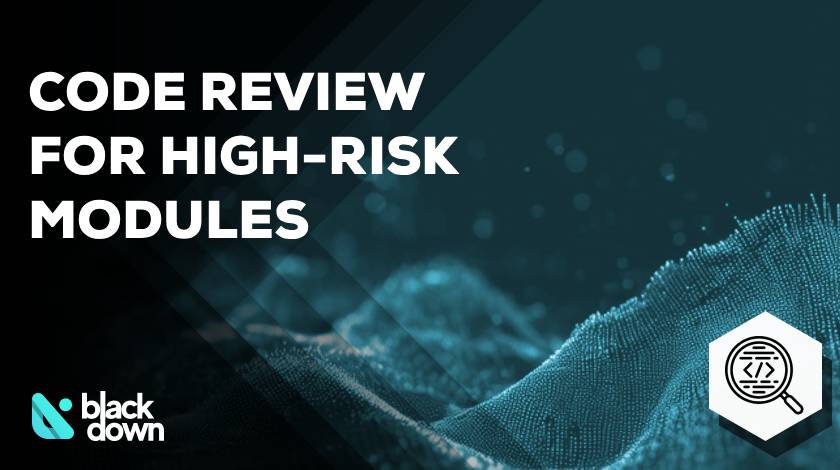Some parts of your codebase carry a larger blast radius. Authentication paths decide who gets in. Payment flows move money and handle cardholder data. Sensitive data pipelines touch PII, tokens, and secrets. When these modules go wrong, you don’t get minor bugs; you get outages, fraud, or breaches.
Regular security audits and code reviews are your first safety net to catch issues early and reduce the likelihood of hard-to-detect vulnerabilities making it to production, a point we’ve emphasized across multiple posts on secure development practices.
What makes a module “high risk”
- It processes or stores sensitive data (credentials, tokens).
- It grants or brokers access rights (auth, session creation, key issuance).
- It triggers value transfer (payments, refunds, bonuses, credit issuance) or policy decisions (KYC, risk scores).
- It integrates with external systems whose failures or misconfigurations can cascade into your environment.
Authentication: what to check
1. Credentials storage and MFA
- Enforce strong credential storage (modern password hashing and salts), but push your roadmap toward passwordless authentication to reduce phishing and credential stuffing risk. Passwordless improves both security and UX when implemented with appropriate backup factors and lifecycle controls.
- Multi-factor authentication (MFA) is required for privileged operations and admin panels; if you offer SSO, validate the IdP configuration, audience restrictions, and signature checks.
2. Authorization and least privilege
- Centralize authorization decisions and perform explicit allow checks in the service layer, not just the UI.
- Apply the principle of the least privilege across users, service accounts, and machine identities. Review entitlements regularly to prevent privilege creep and remove stale access; automated UAR helps keep pace with changes.
3. Sessions and tokens
- Use secure, HTTP-only cookies with appropriate SameSite settings; rotate session identifiers on privilege changes; short TTLs for high-value actions.
- Validate JWTs server-side for audience, issuer, expiry, and signature; never accept “none” algorithms; don’t log tokens or secrets.
4. Resilience and telemetry
- Rate-limit login and OTP endpoints; lock out or step-up auth on suspicious behavior.
- Emit structured security logs that capture high-signal events (failed logins, unusual geos), and monitor continuously to speed up triage and root cause analysis.
Payments: security-by-design without breaking UI
Payments combine high-value targets with strict compliance. That’s why secure payment gateways prioritize encryption, PCI‑DSS compliance, and robust fraud controls by design. During code review, focus on:
1. Compliance and transport
- Confirm PCI DSS scoping: ensure cardholder data never touches systems that aren’t in scope; prefer tokenization over storing raw PANs.
- Enforce TLS everywhere with modern ciphers and HSTS, and display trust signals clearly; users rely on visible security cues like valid certificates and PCI compliance badges to assess risk during checkout.
2. Data minimization and tokenization
- Replace direct handling of card data with provider tokens; this cuts the impact of breaches and reduces audit surface.
3. API correctness and verification
- Verify webhook signatures using shared secrets or asymmetric keys; implement replay protection (timestamps, nonce) and idempotency keys for payment mutations to prevent double-charges and race conditions.
- Validate request payloads rigorously; reject unexpected fields; enforce strict schema checks.
4. UX that prevents errors
- Implement real-time feedback and error handling at the payment form step and network layers so users know what to fix without re-submitting; this lowers abandonment without compromising security.
- Test exhaustively: high-volume bursts, multiple methods, device and network variants. Skipping these phases is a top cause of hidden defects and costly incidents during scale events.
- Keep flows short and predictable; unnecessary redirects or steps increase cart abandonment and are a frequent anti-pattern in payment gateway integrations.
Sensitive data handling
1. Classify and minimize
- Start by classifying what you collect; then aggressively minimize. If you don’t need it, don’t ask for it. If you must store it, isolate it.
2. Encryption everywhere
- Encrypt data in transit and at rest; manage keys in a hardened KMS with rotation and least privilege access to key material. This guidance on using encryption for sensitive information in remote-access scenarios applies broadly to application data, too.
3. Tokenization and redaction
- Tokenize high-risk fields (PANs, SSNs) and redact sensitive values at service boundaries. This aligns with broader recommendations to substitute sensitive data with non-sensitive tokens to cut blast radius.
4. Logging and retention
- Avoid secrets and PII in logs. Apply monitoring and logging that flag anomalies in real time, then scope log retention to legal and business needs to reduce exposure.
5. Securing APIs
- Treat external and internal APIs alike: enforce strong authentication and authorization, rate limiting, input validation, and TLS.
6. CI/CD and environment controls
- Automate security checks early: static analysis, IaC scanners, and dependency audits should run on every change. Bake security gates into CI/CD and keep secrets out of source with dedicated managers.
- Watch for cloud risks such as misconfigurations and entitlement sprawl; continuously reinforce identity controls and data protections to counter data-breach vectors in cloud-native stacks.
A quick word on code review as a service
For high‑risk modules, independence matters. Code review as a service brings expert reviewers who aren’t embedded in your team’s shortcuts or assumptions. The best providers use structured checklists mapped to standards (e.g., auth flows, PCI data flows, secrets management), threat-model the change set, and pair manual review with targeted tests. This approach catches integration hazards like a missing webhook signature check or a logging leak. It’s also an efficient way to demonstrate continuous due diligence to auditors and customers while accelerating delivery by unblocking critical merges.
“Review checklist” you can copy
- Authentication
- Verify factor enrollment, recovery paths, and session rotation.
- Confirm least privilege for admin routes and service accounts.
- Validate token audience/issuer/expiry; block weak algorithms.
- Payments
- Ensure secure payment gateways and don’t store raw card data; rely on tokenization and provider vaults.
- Enforce webhook verification, idempotency, and replay protection.
- Include real-time feedback; keep flows short; test at scale.
- Sensitive data
- Encrypt in transit/at rest; segregate keys; rotate regularly.
- Apply monitoring and logging; avoid secrets and PII in logs; prefer securing APIs with strong authZ and rate limits.
Key takeaways
Treat authentication, payments, and sensitive data handling as special cases, and review them with explicit, opinionated checklists. Prefer passwordless authentication paired with MFA to cut credential risk while improving the overall user experience.
Lean on tokenization and strong encryption to minimize exposure, and enforce least privilege with continuous monitoring to keep controls tight. Invest in CI/CD guardrails and consider code review as a service to add independent, repeatable security scrutiny to every high‑risk change.
Thomas Hyde
Related posts
Popular Articles
Best Linux Distros for Developers and Programmers as of 2025
Linux might not be the preferred operating system of most regular users, but it’s definitely the go-to choice for the majority of developers and programmers. While other operating systems can also get the job done pretty well, Linux is a more specialized OS that was…
How to Install Pip on Ubuntu Linux
If you are a fan of using Python programming language, you can make your life easier by using Python Pip. It is a package management utility that allows you to install and manage Python software packages easily. Ubuntu doesn’t come with pre-installed Pip, but here…











